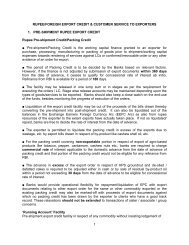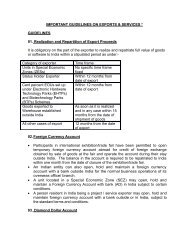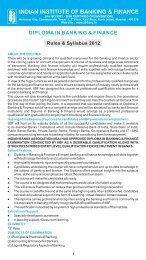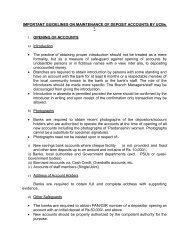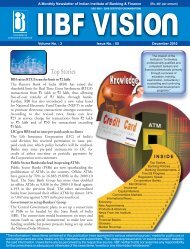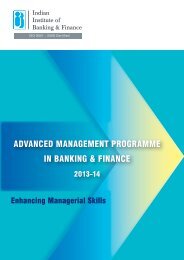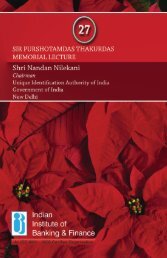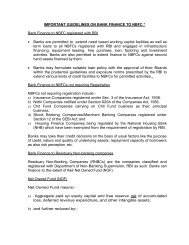You also want an ePaper? Increase the reach of your titles
YUMPU automatically turns print PDFs into web optimized ePapers that Google loves.
special featurethrespondents and published in BFM issue dated 28October to 24th November 2011 issue, wherein UnionBank of India has been ranked the Best NationalizedBank and the fourth best bank among all the banks in thecountry. The 10 parameters of the survey aretrustworthy, response time, well trained staff, phonebanking, ATM network coverage, complaint resolution,banking hour convenience, transaction efficiency anddisclosures.The days are not far off when the Bank will be judgedas number 1 retail bank in customer service excellenceand true to it's tagline “your dreams are not yours alone”.Why Asian Exports Were Worst AffectedEast Asia has particularly benefited from trade liberalization asreflected in the export-led industrialisation in these countries. Thisis perceived to have led to intra-regional spillover effects, mainlyemanating from technological transfers through direct investmentfrom Japan, and indirectly from "hollowing out" of the industrialeconomies. Each shift in the industrial focus of the Japaneseeconomy, from light to heavy electronics and hi-tech industries,created market opportunities for other economies in the region suchas Korea and Taiwan. Even within the electronics industries, midrangegoods gradually began to be supplied by Korea, Taiwan,Singapore, and Malaysia, and only the most sophisticated goodswere produced in Japan. More recently, as Korea, Taiwan andSingapore started specialising in the heavy and hi-tech goodssectors, the light industries were picked up by Thailand, thePhilippines and Indonesia.This sequence of industrialisation, often called the "flying geesepattern", succeeded in the East Asian economies in passing on thecomparative advantages in manufacturing from a leader to thefollowers, and then to the followers' followers. A sequential pattern ofindustrialisation was observed from the agricultural sector to theindustrial sector with small capital requirements to heavy andpetrochemical Industries, and to precision and electronics industries,with latecomers repeating the changes in industrial composition.High exports growth in the Asian countries has been possible on theback of a strong domestic industrial sector which created a base forsustainable growth. The value added in the industrial sector duringthe high-growth phase exceeded 10 per cent (per annum) in theseeconomies. Today, several developing economies in Asia are part ofa manufacturing supply chain for exports to advanced economies. Insome of these countries, like Malaysia, the Republic of Korea,Singapore, Taiwan and Thailand, exports of manufactures representa substantial share of their GDP.On the back of rising manufacturing exports as well as strongdomestic fundamentals, the Asian region has become a strongeconomic driver for the world with a rising share in output, trade andreserves (Table). During the current crisis, however, the abruptdeceleration in growth in Asia was more rapid than in other regions,and in key countries even sharper than at the epicentre of the globalcrisis due to the greater integration of these economies. In manyways, this severe impact was unexpected. Asia is far from theTable : Developing Asia : The EmergingEconomic Driver of the WorldYear Share (%) in the WorldGDP Exports Imports Reserves1 2 3 4 51980 7.2 4.2 4.6 8.61985 8.6 4.9 5.9 15.21990 10.1 5.3 5.8 6.91995 13.5 8.2 8.8 12.32000 15.2 9.6 8.5 15.72005 18.3 12.7 11.9 27.12010 / Latest 22.9 14.5 13.3 33.8Source : WEO database; IFS (IMF).epicentre of the crisis, not just geographically but also in the sensethat it did not indulge in the financial practices that led to seriousproblems in advanced economies' banking systems. Moreover,before the crisis, the region was in sound macroeconomic shape,and thus in a strong position to resist the pressures emanating fromadvanced economies. Therefore, what explains the outcomecontrary to expectations? The answer lies in Asia's exceptionalintegration with the global economy. Much of Asia relies heavily ontechnologically sophisticated manufacturing exports for whichdemand had collapsed. At the same time, Asia's financial ties withthe rest of the world have deepened over the past decade, exposingthe region to the forces of global deleveraging.Countries with a larger share of advanced manufacturing inGDP experienced sharper output declines. The underlying reasonis that advanced manufacturing is more cyclically sensitive thanother items. Growth in Asian economies with a lower share ofmanufacturing, such as commodity exporters, initially held upbetter, although the collapse in commodity prices hit them aswell. The collapse in demand has been transmitted through theintegrated supply chain with dramatic effects on intra-regionaltrade. The current crisis vividly illustrates that Asia has not"decoupled" from the global economy. Synchronised recession inadvanced economies has further complicated the matter during thecurrent crisis as against the experience in 1998 when the decline indomestic demand was offset to some extent by demand emanatingfrom industrial economies.Source : Report on Currency & Finance, 2008-09, RBI32October - December 2011The Journal of Indian Institute of Banking & Finance



